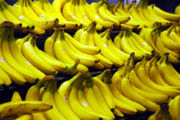Thursday, March 27, 2008
+bunch+of+FHIA-17+bananas..jpg)
ate a banana at
10:52 PM ;D
Sunday, March 16, 2008
While in no danger of outright extinction, the most common edible banana cultivar 'Cavendish' (extremely popular in Europe and the Americas) could become unviable for large-scale cultivation in the next 10-20 years. Its predecessor 'Gros Michel', discovered in the 1820s, has already suffered this fate. Like almost all bananas, it lacks genetic diversity, which makes it vulnerable to diseases, which threaten both commercial cultivation and the small-scale subsistence farming. Major diseases include:
Panama Disease (Race 1) – fusarium wilt (a soil fungus). The fungus enters the plants through the roots and moves up with water into the trunk and leaves, producing gels and gums. These plug and cut off the flow of water and nutrients, causing the plant to wilt. Prior to 1960 almost all commercial banana production centered on the cultivar 'Gros Michel', which was highly susceptible to fusarium wilt. The cultivar 'Cavendish' was chosen as a replacement for 'Gros Michel' because out of the resistant cultivars it was viewed as producing the highest quality fruit. However, more care is required for shipping the 'Cavendish' banana, and its quality compared to 'Gros Michel' is debated.
Tropical Race 4 - a reinvigorated strain of Panama Disease first discovered in 1993. This is a virulent form of fusarium wilt that has wiped out 'Cavendish' in several southeast Asian countries. It has yet to reach the Americas; however, soil fungi can easily be carried on boots, clothing, or tools. This is how Tropical Race 4 moves from one plantation to another and is its most likely route into Latin America. The Cavendish cultivar is highly susceptible to TR4, and over time, Cavendish is almost certain to be eliminated from commercial production by this disease. Unfortunately the only known defense to TR4 is genetic resistance.
Black Sigatoka - a fungal leaf spot disease first observed in Fiji in 1963 or 1964. Black Sigatoka (also known as Black Leaf Streak) has spread to banana plantations throughout the tropics due to infected banana leaves being used as packing material. It affects all of the main cultivars of bananas and plantains, impeding photosynthesis by turning parts of their leaves black, and eventually killing the entire leaf. Being starved for energy, fruit production falls by 50% or more, and the bananas that do grow suffer premature ripening, making them unsuitable for export. The fungus has shown ever increasing resistance to fungicidal treatment, with the current expense for treating 1 hectare exceeding US$1000 per year. In addition to the financial expense there is the question of how long such intensive spraying can be justified environmentally. Several resistant cultivars of banana have been developed, but none has yet received wide scale commercial acceptance due to taste and texture issues.
Banana Bunchy Top Virus (BBTV) - this virus is spread from plant to plant by aphids. It causes stunting of the leaves resulting in a "bunched" appearance. Generally, a banana plant infected with the virus will not set fruit, although mild strains exist in many areas which do allow for some fruit production. These mild strains are often mistaken for malnourishment, or a disease other than BBTV. There is no cure for BBTV, however its effect can be minimised by planting only tissue cultured plants (In-vitro propagation), controlling the aphids, and immediately removing and destroying any plant from the field that shows signs of the disease.
Even though it is no longer viable for large scale cultivation, 'Gros Michel' is not extinct and is still grown in areas where Panama Disease is not found. Likewise, 'Cavendish' is in no danger of extinction, but it may leave the shelves of the supermarkets for good if diseases make it impossible to supply the global market. It is unclear if any existing cultivar can replace 'Cavendish' on a scale needed to fill current demand, so various hybridisation and genetic engineering programs are working on creating a disease-resistant, mass-market banana.
Australia is relatively free of plant diseases and therefore prohibits imports. When Cyclone Larry wiped out Australia's domestic banana crop in 2006, bananas became relatively expensive, due to low supply domestically, and laws prohibiting banana imports.
ate a banana at
10:53 PM ;D
Thursday, February 28, 2008

ate a banana at
10:51 PM ;D
Friday, February 22, 2008

ate a banana at
10:51 PM ;D
Monday, February 11, 2008
The banana plant is a pseudostem that grows to 6 to 7.6 metres (20-25 feet) tall, growing from a corm. Leaves are spirally arranged and may grow 2.7 metres (9 feet) long and 60 cm (2 feet) wide.
ate a banana at
10:50 PM ;D
Tuesday, January 29, 2008

ate a banana at
10:41 PM ;D
Sunday, January 20, 2008

ate a banana at
10:42 PM ;D
+bunch+of+FHIA-17+bananas..jpg)



